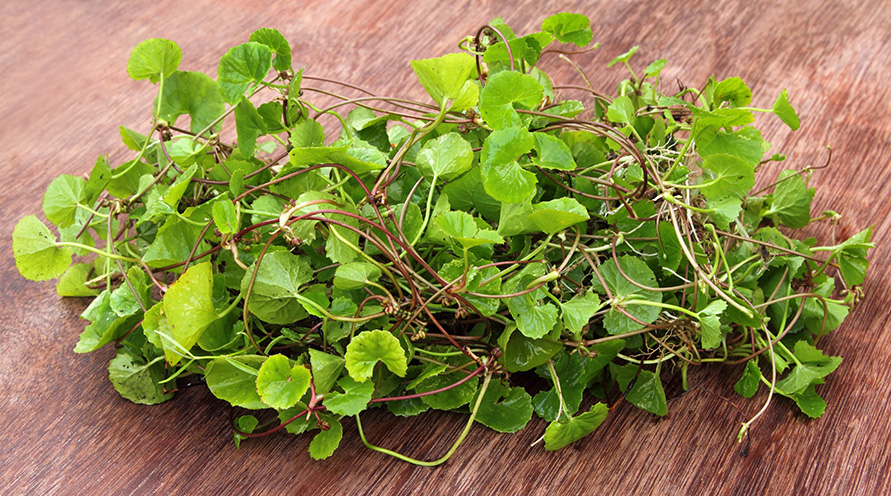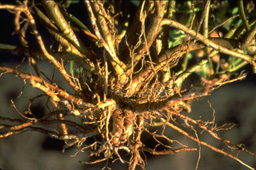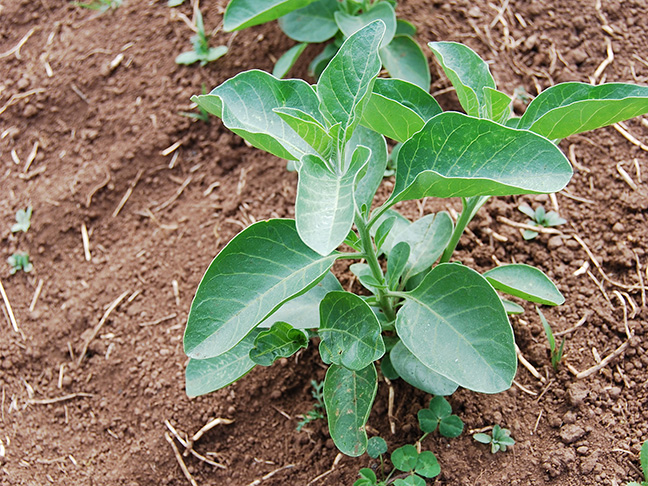Botanicals of Interest
The BENFRA Center examines two popular botanical dietary supplements in the U.S., Centella asiatica (L.) Urban (CA; family Apiaceae) and Withania somnifera (L.) Dunal (WS; family Solanaceae). Both are highly regarded in the Ayurvedic tradition as rejuvenating herbs1 (“rasayana”). The first is sold as gotu kola, the second as ashwagandha. Based on the number of registered labels,2 there are over 200 dietary supplements containing CA and over 400 dietary supplements containing WS available for purchase in the US. In one survey, WS was listed as the sixth top selling herb in US in 2017,3 up from eighth position in 2016.4 Scientific studies suggest the utility of CA and WS to support resilience to neurological changes experienced in aging such as cognitive decline, and sleep and mood disturbances. Both botanicals have been the subject of earlier clinical studies. However, the studies range widely in methodological quality, product characterization, justification of doses, subject population and end points. Well-designed clinical trials are critically needed to reliably evaluate the potential of these botanicals to support age-related neurological and functional changes.
Based on their widespread use in the US, and compelling evidence for biological activity, the BENFRA Center will conduct a battery of studies to support the design of optimum clinical trials of these two botanicals. We have been working with CA for several years and will build on those studies. We are eager to apply our collaborative expertise in relevant methods to WS, as a new candidate for our research.
Centella asiatica (CA)
Biological effects of Centella asiatica

A substantial body of literature supports the neurological and neurotropic effects of CA.5 CA improves cognition in rodent models of oxidative stress,6-8 and in mouse models of Alzheimer’s disease (AD) and aging as shown by studies in our lab.9-12 We have found that CA appears to work by improving antioxidant response, ameliorating mitochondrial dysfunction and increasing dendritic arborization,13-16 effects which are relevant to both pathological and normal aging. In clinical studies, CA extract or dried herb improved cognitive function of healthy middle-aged and elderly17,18 and as well as elderly subjects with mild cognitive impairment.19 Anxiolytic20-22 and antidepressant23,24 properties of CA have been reported in rodent models. CA treatment showed similar effects in humans.19,25 CA has been reported to be used for sleep disorders,26 but has not been investigated systematically for this use. CA prevented some of the behavioral changes in a mouse model of extreme sleep deprivation,22 and in a clinical study of cognition and mood, self-reported insomnia was decreased with CA treatment.19
Phytochemical and known active compounds of CA
CA is most known for its high content of pentacyclic triterpenoids.27,28 The saponins, asiaticoside (AS) and madecassoside (MS), and their aglycones, asiatic acid (AA) and madecassic acids (MA), are the most abundant and widely studied pentacyclic triterpenoids in CA. Saponins account for up to 8% of the dry mass of the herb.29 Less abundant components of CA include chlorogenic acids, a diverse group formed by quinic acid esterified to cinnamic acid derivatives, including caffeoylquinic acids (CQAs).30 Several isomeric dicaffeoylquinic esters are commonly found in CA: 1,3-, 1,4- 1,5-, 3,4-, 3,5- and 4,5-diCQA,31 some of which have the trivial names isochlorogenic acid A, B or C. CA contains many phenolic constituents, including flavonoids, such as catechin, epicatechin, kaempferol, quercetin and related glycoside.30 Many of the neurotropic and neuroprotective properties of CA have been associated with the triterpene compounds AS and AA.5 However, we14,31 and others have discovered that CQAs found in CA also confer neurotropic and neuroprotective effects including cognitive effects. 32-35
Withania somnifera (WS)
Biological effects of Withania somnifera

Neuropharmacological effects of WS root and WS leaf have both been studied in preclinical and clinical models and are the subject of recent reviews.36-38 Cognitive improvement has been seen in rodent models treated with WS root39 or leaf40-43 extracts, and also reported in humans44-46 taking WS products. Antidepressant and anxiolytic effect of WS are reported in mice47-49 and in multiple human studies.50-56 In rodents, WS extracts increased non-REM sleep,43 and ameliorated cognitive and motor deficits, and alterations in synaptic proteins43,57,58 and EEG and EMG patterns59 induced by sleep deprivation. Several clinical studies51,52,55,60 also report improved sleep quality for WS products.

Chemistry and known active compounds of WS
The best-known compounds of WS are a complex group of steroidal lactones known as withanolides, which also occur as glycosides (withanosides). Over 40–60 individual withanolide derivatives have been reported in WS leaf and root,61,62 with higher levels in the leaves than the roots.63 The existence of WS chemotypes has been reported.64 Withanolides are considered to be the main active compounds of WS65,66 including for neurological effects. For example, withanone67 and withanolide A,68 sominone68 and withanoside IV68 all improved memory in cognitively impaired rodents. In vitro, withanolide A and withanosides IV and VI and sominone were also associated with increased neuritic extension and markers of synaptic health.69, 70 WS also contains multiple steroidal alkaloids65,71 and phenolic compounds72 and sitoindosides (long chain acylsterylglucosides)71 which, by contrast, have received very little attention for their neurological activities. Triethylene glycol has been suggested to be the active compound for sleep induction in mice73 although the concentrations used seem high compared to the parent WS extract. Some withanolides contain electrophilic sites conferring thiol reactivity which may play important roles in mediating biological activity associated with antioxidant and heat-shock-inducing activity and/or targeting other electrophile sensors that modulate transcriptional or post-transcriptional responses.74
References
1. Balasubramani SP, Venkatasubramanian P, Kukkupuni SK, Patwardhan B. Plant-based Rasayana drugs from Ayurveda. Chinese Journal of Integrative Medicine. 2011;17(2):88-94.
2. Supplements NOoD. NIH Office of Dietary Supplement labels database. Accessed 08/10, 2017.
3. Smith S, Kawa K, Eckl V, Morton C, Stredney R. Herbal Supplement Sales in US Increased 8.5% in 2017, Topping $8 Billion: Strongest sales growth in more than 15 years bolstered by continued popularity of Ayurvedic herbs and new formulations of botanicals with general health and nutrition benefits. HerbalGram. 2018(119):62-71.
4. Smith T, Kawa K, Eckl V, Morton C, Stredney R. Herbal Supplement Sales in US Increase 7.7% in 2016: Consumer preferences shifting toward ingredients with general wellness benefits, driving growth of adaptogens and digestive health products. HerbalGram. 2017(115):56-65.
5. Gray NE, Alcazar Magana A, Lak P, et al. Centella asiatica: phytochemistry and mechanisms of neuroprotection and cognitive enhancement. Phytochem Rev. 2017:1-34.
6. Veerendra Kumar MH, Gupta YK. Effect of Centella asiatica on cognition and oxidative stress in an intracerebroventricular streptozotocin model of Alzheimer's disease in rats. Clinical & Experimental Pharmacology & Physiology. 2003;30(5-6):336-342.
7. Veerendra Kumar MH, Gupta YK. Effect of different extracts of Centella asiatica on cognition and markers of oxidative stress in rats. Journal of ethnopharmacology. 2002;79(2):253-260.
8. Gupta YK, Veerendra Kumar MH, Srivastava AK. Effect of Centella asiatica on pentylenetetrazole-induced kindling, cognition and oxidative stress in rats. Pharmacology, Biochemistry & Behavior. 2003;74(3):579-585.
9. Gray NE, Harris CJ, Quinn JF, Soumyanath A. Centella asiatica modulates antioxidant and mitochondrial pathways and improves cognitive function in mice. J Ethnopharmacol. 2016;180:78-86.
10. Gray NE, Zweig JA, Caruso M, et al. Centella asiatica increases hippocampal synaptic density and improves memory and executive function in aged mice. Brain Behav. 2018;8(7):e01024.
11. Gray NE, Zweig JA, Caruso M, et al. Centella asiatica attenuates hippocampal mitochondrial dysfunction and improves memory and executive function in beta-amyloid overexpressing mice. Mol Cell Neurosci. 2018;93:1-9.
12. Soumyanath A, Zhong YP, Henson E, Wadsworth T, Bishop J, Gold BG, Quinn JF., . Centella asiatica Extract Improves Behavioral Deficits in a Mouse Model of Alzheimer's Disease: Investigation of a Possible Mechanism of Action. Int J Alzheimers Dis,. 2012:381974.
13. Gray NE, Sampath H, Zweig JA, Quinn JF, Soumyanath A. Centella asiatica Attenuates Amyloid-beta-Induced Oxidative Stress and Mitochondrial Dysfunction. J Alzheimers Dis. 2015;45:933-946.
14. Gray NE, Zweig JA, Murchison C, et al. Centella asiatica attenuates Aβ-induced neurodegenerative spine loss and dendritic simplification. Neurosci Lett. 2017;646:24-29.
15. Gray NE, Zweig JA, Matthews DG, Caruso M, Quinn JF, Soumyanath A. Centella asiatica Attenuates Mitochondrial Dysfunction and Oxidative Stress in Abeta-Exposed Hippocampal Neurons. Oxid Med Cell Longev. 2017;2017:7023091.
16. Matthews DG, Caruso M, Murchison CF, et al. Centella Asiatica improves memory and promotes antioxidative signaling in 5XFAD mice. Antioxidants (Basel). 2019;8(12).
17. Dev RDO, Mohamed, S., Hambali, Z. & Samah, B.A.,. Comparison on cognitive effects of Centella asiatica in healthy middle aged female and male volunteers. European Journal of Scientific Research. 2009;31(4):553-565.
18. Wattanathorn J, Mator L, Muchimapura S, et al. Positive modulation of cognition and mood in the healthy elderly volunteer following the administration of Centella asiatica. J Ethnopharmacol. 2008;116(2):325-332.
19. Tiwari S, Singh, S., Patwardhan, K., Gehlot, S. & Gambhir, I.S.,. Effect of Centella asiatica on mild cognitive impairment (MCI) and other common agerelated clinical problems. Digest Journal of Nanomaterials and Biostructures. 2008;3(4):215-220.
20. Wanasuntronwong A, Tantisira MH, Tantisira B, Watanabe H. Anxiolytic effects of standardized extract of Centella asiatica (ECa 233) after chronic immobilization stress in mice. J Ethnopharmacol. 2012;143(2):579-585.
21. Wijeweera P, Arnason JT, Koszycki D, Merali Z. Evaluation of anxiolytic properties of Gotukola--(Centella asiatica) extracts and asiaticoside in rat behavioral models. Phytomedicine. 2006;13(9-10):668-676.
22. Chanana P, Kumar A. Possible Involvement of Nitric Oxide Modulatory Mechanisms in the Neuroprotective Effect of Centella asiatica Against Sleep Deprivation Induced Anxiety Like Behaviour, Oxidative Damage and Neuroinflammation. Phytother Res. 2016;30(4):671-680.
23. Kalshetty P, Aswar U, Bodhankar S, Sinnathambi A, Mohan V, Thakurdesai P. . Antidepressant effects of standardized extract of Centella asiatica L. in olfactory bulbectomy model. Biomed Aging Pathol. 2012;2(2):48-53.
24. Selvi PT KM, Rajesh R, Kathiravan T. . Antidepressant activity of ethanolic extract of leaves of Centella asiatica Linn. by in vivo methods. Asian J Res Pharm Sci. 2012;2(2):76-79.
25. Jana U, Sur TK, Maity LN, Debnath PK, Bhattacharyya D. A clinical study on the management of generalized anxiety disorder with Centella asiatica. Nepal Med Coll J 12. 2010;1(8-11).
26. Cauffield JS, Forbes HJ. Dietary supplements used in the treatment of depression, anxiety, and sleep disorders. Lippincotts Prim Care Pract. 1999;3(3):290-304.
27. James JT, Dubery IA. Pentacyclic triterpenoids from the medicinal herb, Centella asiatica (L.) Urban. Molecules. 2009;14(10):3922-3941.
28. Azerad R. Chemical structures, production and enzymatic transformations of sapogenins and saponins from Centella asiatica (L.) Urban. Fitoterapia. 2016;114:168-187.
29. James J, Dubery I. Identification and Quantification of Triterpenoid Centelloids in Centella asiatica (L.) Urban by Densitometric TLC. Jpc-J Planar Chromat. 2011;24(1):82-87.
30. Ncube EN, Steenkamp PA, Madala NE, Dubery IA. Chlorogenic Acids Biosynthesis in Centella asiatica Cells Is not Stimulated by Salicylic Acid Manipulation. Appl Biochem Biotech. 2016;179(5):685-696.
31. Gray NE, Morré J, Kelley J, et al. Caffeoylquinic Acids in Centella asiatica Protect against Amyloid-β Toxicity. J Alzheimer's Dis. 2014;40:359–373.
32. Sasaki K, Han J, Shimozono H, Villareal M, Isoda H. Caffeoylquinic acid-rich purple sweet potato extract, with or without anthocyanin, imparts neuroprotection and contributes to the improvement of spatial learning and memory of SAMP8 mouse. J Agric Food Chem. 2013;61(21):5037-5045.
33. Han J, Miyamae Y, Shigemori H, Isoda H. Neuroprotective effect of 3,5-di-O-caffeoylquinic acid on SH-SY5Y cells and senescence-accelerated-prone mice 8 through the up-regulation of phosphoglycerate kinase-1. Neuroscience. 2010;169(3):1039-1045.
34. Kwon S, Lee H, Kim J, et al. Neuroprotective effects of chlorogenic acid on scopolamine-induced amnesia via anti-acetylcholinesterase and anti-oxidative activities in mice. Eur J Pharmacol. 2010;649(1-3):210-217.
35. Choi S, Kim J, Suh S, et al. Ligularia fischeri extract protects against oxidative-stress-induced neurotoxicity in mice and PC12 cells. J Med Food. 2014;17(11):1222-1231.
36. Yenisetti SC, Manjunath MJ, Muralidhara. Neuropharmacological Properties of Withania somnifera - Indian Ginseng: An Overview on Experimental Evidence with Emphasis on Clinical Trials and Patents. Recent Patents on CNS Drug Discovery. 2016;10(2):204-215.
37. Kuboyama T, Tohda C, Komatsu K. Effects of Ashwagandha (Roots of Withania somnifera) on neurodegenerative diseases. Biol Pharm Bull. 2014;37(6):892-897.
38. Durg S, Dhadde SB, Vandal R, Shivakumar BS, Charan CS. Withania somnifera (Ashwagandha) in neurobehavioural disorders induced by brain oxidative stress in rodents: A systematic review and meta-analysis. J Pharm Pharmacol. 2015;67(7):879-899.
39. Sood A, Mehrotra A, Dhawan DK, Sandhir R. Indian Ginseng (Withania somnifera) supplementation ameliorates oxidative stress and mitochondrial dysfunctions in experimental model of stroke. Metab Brain Dis. 2018;33(4):1261-1274.
40. Gautam A, Kaul SC, Thakur MK. Alcoholic Extract of Ashwagandha Leaves Protects Against Amnesia by Regulation of Arc Function. Mol Neurobiol. 2016;53(3):1760-1769.
41. Gautam A, Wadhwa R, Thakur MK. Involvement of hippocampal Arc in amnesia and its recovery by alcoholic extract of Ashwagandha leaves. Neurobiol Learn Mem. 2013;106:177-184.
42. Manchanda S, Kaur G. Withania somnifera leaf alleviates cognitive dysfunction by enhancing hippocampal plasticity in high fat diet induced obesity model. BMC Complement Altern Med. 2017;17(1):136.
43. Manchanda S, Mishra R, Singh R, Kaur T, Kaur G. Aqueous Leaf Extract of Withania somnifera as a Potential Neuroprotective Agent in Sleep-deprived Rats: a Mechanistic Study. Mol Neurobiol. 2017;54(4):3050-3061.
44. Pingali U, Pilli R, Fatima N. Effect of standardized aqueous extract of Withania somnifera on tests of cognitive and psychomotor performance in healthy human participants. Pharmacognosy Res. 2014;6(1):12-18.
45. Choudhary D, Bhattacharyya S, Bose S. Efficacy and Safety of Ashwagandha (Withania somnifera (L.) Dunal) Root Extract in Improving Memory and Cognitive Functions. Journal of dietary supplements. 2017;14(6):599-612.
46. Chengappa KN, Bowie CR, Schlicht PJ, Fleet D, Brar JS, Jindal R. Randomized placebo-controlled adjunctive study of an extract of withania somnifera for cognitive dysfunction in bipolar disorder. The Journal of clinical psychiatry. 2013;74(11):1076-1083.
47. Attari M, Jamaloo F, Shadvar S, Fakhraei N, Dehpour AR. Effect of Withania somnifera Dunal Root Extract on Behavioral Despair Model in Mice: a Possible Role for Nitric Oxide. Acta Med Iran. 2016;54(3):165-172.
48. Bhattacharya SK, Bhattacharya A, Sairam K, Ghosal S. Anxiolytic-antidepressant activity of Withania somnifera glycowithanolides: an experimental study. Phytomedicine. 2000;7(6):463-469.
49. Kaur T, Singh H, Mishra R, et al. Withania somnifera as a potential anxiolytic and immunomodulatory agent in acute sleep deprived female Wistar rats. Mol Cell Biochem. 2017;427(1-2):91-101.
50. Cooley K, Szczurko O, Perri D, et al. Naturopathic care for anxiety: a randomized controlled trial ISRCTN78958974. PLoS One. 2009;4(8):e6628.
51. Rani PU, Naidu MU, Kumar TR, Shobha JC. Evaluation of the efficacy and safety of a new herbal revitalizer revivin. Anc Sci Life. 1997;16(3):190-195.
52. Modi MB, Donga SB, Dei L. Clinical evaluation of Ashokarishta, Ashwagandha Churna and Praval Pishti in the management of menopausal syndrome. Ayu. 2012;33(4):511-516.
53. Auddy B, Hazra J, Mitra A, Abedon B, Ghosal S. A Standardized Withania Somnifera Extract Significantly Reduces Stress-Related Parameters in Chronically Stressed Humans: A Double-Blind, Randomized, Placebo-Controlled Study. JANA. 2008;11(1):50-56.
54. Andrade C, Aswath A, Chaturvedi SK, Srinivasa M, Raguram R. A double-blind, placebo-controlled evaluation of the anxiolytic efficacy ff an ethanolic extract of withania somnifera. Indian J Psychiatry. 2000;42(3):295-301.
55. Chandrasekhar K, Kapoor J, Anishetty S. A prospective, randomized double-blind, placebo-controlled study of safety and efficacy of a high-concentration full-spectrum extract of ashwagandha root in reducing stress and anxiety in adults. Indian J Psychol Med. 2012;34(3):255-262.
56. Khyati SS, Anup TB. A Randomized Double Blind Placebo Controlled Study of Ashwagandha on Generalized Anxiety Disorder. International Ayurvedic Medical Journal. 2013;1(5):1-7.
57. Manchanda S, Mishra R, Singh R, Kaur T, Kaur G. Aqueous Leaf Extract of Withania somnifera as a Potential Neuroprotective Agent in Sleep-deprived Rats: a Mechanistic Study. Mol Neurobiol. 2017;54(4):3050-3061.
58. Kumar A, Kalonia H. Protective effect of Withania somnifera Dunal on the behavioral and biochemical alterations in sleep-disturbed mice (Grid over water suspended method). Indian journal of experimental biology. 2007;45(6):524-528.
59. Kumar A, Kalonia H. Effect of Withania somnifera on Sleep-Wake Cycle in Sleep-Disturbed Rats: Possible GABAergic Mechanism. Indian J Pharm Sci. 2008;70(6):806-810.
60. Raut AA, Rege NN, Tadvi FM, et al. Exploratory study to evaluate tolerability, safety, and activity of Ashwagandha (Withania somnifera) in healthy volunteers. J Ayurveda Integr Med. 2012;3(3):111-114.
61. Chatterjee S, Srivastava S, Khalid A, et al. Comprehensive metabolic fingerprinting of Withania somnifera leaf and root extracts. Phytochemistry. 2010;71(10):1085-1094.
62. Trivedi MK, Panda P, Sethi KK, Jana S. Metabolite Profiling in Withania somnifera Roots Hydroalcoholic Extract Using LC/MS, GC/MS and NMR Spectroscopy. Chem Biodivers. 2017;14(3).
63. Kaul SC, Ishida Y, Tamura K, et al. Novel Methods to Generate Active Ingredients-Enriched Ashwagandha Leaves and Extracts. PLoS One. 2016;11(12):e0166945.
64. Bhatia A, Bharti SK, Tewari SK, Sidhu OP, Roy R. Metabolic profiling for studying chemotype variations in Withania somnifera (L.) Dunal fruits using GC-MS and NMR spectroscopy. Phytochemistry. 2013;93:105-115.
65. Alam N, Hossain M, Khalil MI, Moniruzzaman M, Sulaiman SA, Gan SH. Recent advances in elucidating the biological properties of Withania somnifera and its potential role in health benefits. Phytochem Rev. 2012;11(1):97-112.
66. Khan SA, Khan SB, Shah Z, Asiria AM. Withanolides: Biologically active constituents in the treatment of Alzheimer's disease. Med Chem. 2016;12(3):238-256.
67. Pandey A, Bani S, Dutt P, Kumar Satti N, Avtar Suri K, Nabi Qazi G. Multifunctional neuroprotective effect of Withanone, a compound from Withania somnifera roots in alleviating cognitive dysfunction. Cytokine. 2018;102:211-221.
68. Kuboyama T, Tohda C, Komatsu K. Withanoside IV and its active metabolite, sominone, attenuate Abeta(25-35)-induced neurodegeneration. Eur J Neurosci. 2006;23(6):1417-1426.
69. Kuboyama T, Tohda C, Zhao J, Nakamura N, Hattori M, Komatsu K. Axon- or dendrite-predominant outgrowth induced by constituents from Ashwagandha. Neuroreport. 2002;13(14):1715-1720.
70. Kuboyama T, Tohda C, Komatsu K. Neuritic regeneration and synaptic reconstruction induced by withanolide A. Br J Pharmacol. 2005;144(7):961-971.
71. Pharmacopoiea AH. Ashwagandha root. Santa Cruz, California: American Herbal Pharmacopoeia;2000.
72. Alam N, Hossain M, Khalil MI, Moniruzzaman M, Sulaiman SA, Gan SH. High catechin concentrations detected in Withania somnifera (ashwagandha) by high performance liquid chromatography analysis. BMC Complement Altern Med. 2011;11:65.
73. Kaushik MK, Kaul SC, Wadhwa R, Yanagisawa M, Urade Y. Triethylene glycol, an active component of Ashwagandha (Withania somnifera) leaves, is responsible for sleep induction. PLoS One. 2017;12(2):e0172508.
74. Wijeratne EM, Xu YM, Scherz-Shouval R, et al. Structure-activity relationships for withanolides as inducers of the cellular heat-shock response. J Med Chem. 2014;57(7):2851-2863.